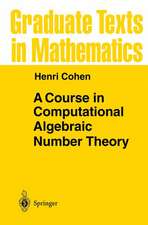Reduce: Software for Algebraic Computation: Symbolic Computation
Autor Gerhard Rayna Prefață de Anthony C. Hearnen Limba Engleză Paperback – 5 oct 1987
Din seria Symbolic Computation
- 20%
 Preț: 350.21 lei
Preț: 350.21 lei - 20%
 Preț: 651.89 lei
Preț: 651.89 lei - 20%
 Preț: 649.09 lei
Preț: 649.09 lei - 20%
 Preț: 648.44 lei
Preț: 648.44 lei - 20%
 Preț: 639.35 lei
Preț: 639.35 lei - 20%
 Preț: 653.06 lei
Preț: 653.06 lei - 20%
 Preț: 642.19 lei
Preț: 642.19 lei - 20%
 Preț: 651.09 lei
Preț: 651.09 lei - 20%
 Preț: 659.97 lei
Preț: 659.97 lei - 20%
 Preț: 645.31 lei
Preț: 645.31 lei - 20%
 Preț: 648.44 lei
Preț: 648.44 lei - 20%
 Preț: 650.27 lei
Preț: 650.27 lei - 20%
 Preț: 646.47 lei
Preț: 646.47 lei -
 Preț: 394.29 lei
Preț: 394.29 lei - 20%
 Preț: 326.46 lei
Preț: 326.46 lei - 20%
 Preț: 342.28 lei
Preț: 342.28 lei - 20%
 Preț: 339.99 lei
Preț: 339.99 lei - 20%
 Preț: 641.01 lei
Preț: 641.01 lei - 20%
 Preț: 657.99 lei
Preț: 657.99 lei - 20%
 Preț: 648.26 lei
Preț: 648.26 lei - 20%
 Preț: 661.47 lei
Preț: 661.47 lei - 15%
 Preț: 638.89 lei
Preț: 638.89 lei - 20%
 Preț: 657.67 lei
Preț: 657.67 lei - 20%
 Preț: 652.73 lei
Preț: 652.73 lei - 20%
 Preț: 330.42 lei
Preț: 330.42 lei - 20%
 Preț: 709.98 lei
Preț: 709.98 lei - 20%
 Preț: 834.69 lei
Preț: 834.69 lei - 20%
 Preț: 656.03 lei
Preț: 656.03 lei - 20%
 Preț: 324.64 lei
Preț: 324.64 lei - 20%
 Preț: 757.48 lei
Preț: 757.48 lei - 20%
 Preț: 355.67 lei
Preț: 355.67 lei - 20%
 Preț: 328.27 lei
Preț: 328.27 lei - 20%
 Preț: 330.24 lei
Preț: 330.24 lei - 20%
 Preț: 342.96 lei
Preț: 342.96 lei - 20%
 Preț: 555.53 lei
Preț: 555.53 lei
Preț: 647.61 lei
Preț vechi: 809.51 lei
-20% Nou
Puncte Express: 971
Preț estimativ în valută:
123.95€ • 128.90$ • 103.72£
123.95€ • 128.90$ • 103.72£
Carte tipărită la comandă
Livrare economică 14-28 martie
Preluare comenzi: 021 569.72.76
Specificații
ISBN-13: 9780387965987
ISBN-10: 038796598X
Pagini: 329
Ilustrații: IX, 329 p.
Dimensiuni: 155 x 235 x 18 mm
Greutate: 0.48 kg
Ediția:Softcover reprint of the original 1st ed. 1987
Editura: Springer
Colecția Springer
Seria Symbolic Computation
Locul publicării:New York, NY, United States
ISBN-10: 038796598X
Pagini: 329
Ilustrații: IX, 329 p.
Dimensiuni: 155 x 235 x 18 mm
Greutate: 0.48 kg
Ediția:Softcover reprint of the original 1st ed. 1987
Editura: Springer
Colecția Springer
Seria Symbolic Computation
Locul publicării:New York, NY, United States
Public țintă
ResearchCuprins
1.Overview.- 1.1. Variables, values, assignments.- 1.2. The basic operations.- 1.3. Giving commands, getting answers.- 1.4. A first look at CLEAR.- 1.5. WS, SAVEAS, INPUT n.- 1.6. Some built-in functions.- 1.7. NUM and DEN.- 1.8. Differentiation.- 1.9. Integration.- 1.10. FOR … DO.- 1.11. FOR … SUM.- 1.12. FOR … PRODUCT.- 1.13. WHILE … DO.- 1.14. Boolean expressions.- 1.15. REPEAT … UNTIL.- 2. A Harder Look.- 2.1. The SUBSTITUTION function.- 2.2. ARRAY and OPERATOR.- 2.3. Matrices.- 2.4. The COEFF function.- 2.5. FACTORIZE.- 2.6. The SOLVE function.- 2.7. LET and CLEAR.- 2.8. WRITE.- 2.9. Grouping.- 2.10. IF… THEN.- 2.11. PART and setting a PART.- 3. Setting Modes and Options.- 3.1. EXP.- 3.2. GCD.- 3.3. LCM.- 3.4. MCD.- 3.5. RESUBS.- 3.6. ORDER.- 3.7. FACTOR command.- 3.8. FACTOR switch.- 3.9. DIV.- 3.10. RAT.- 3.11. ALLFAC.- 3.12. LIST.- 3.13. NERO.- 3.14. NAT, FORT.- 3.15. PRI.- 3.16. KORDER.- 3.17. Domain modes.- 4. Procedures.- 4.1. Procedures without parameters or RETURN.- 4.2. Procedures with RETURN.- 4.3. Returning multiple values.- 4.4. Procedures with one parameter.- 4.5. Procedures with more than one parameter.- 4.6. Procedures with local variables.- 4.7. Interaction of procedures.- 4.8. Linkage questions.- 4.9. Procedures with GO TO.- 4.10. LET rules as procedures.- 5. Case Studies.- 5.1. Find the variables.- 5.2. Dividing polynomials.- 5.3. LCM, GCD, and the Euclidean Algorithm.- 5.4. Systems of linear equations.- 5.5. Series approximations to quotients.- 5.6. Families of polynomials.- 5.7. Rationalizing denominators.- 5.8. A bug involving surds.- 5.9. Noncommuting symbols.- 6. Running REDUCE.- 6.1. The basics.- 6.2. IN from files.- 6.3. Making corrections.- 6.4. INPUT, RETRY, CMD.- 6.5. OUT, FORT, LINELENGTH.- 6.6. COMPILE, FASLOUT, LOAD.- 6.7.TIME, SHOWTIME.- 6.8. DEFINE.- 6.9. Tracing.- 6.10. Expression input.- 6.11. Lost in LISP?.














